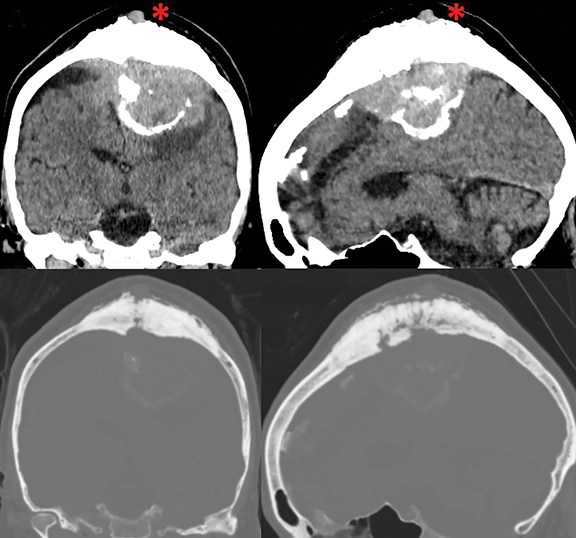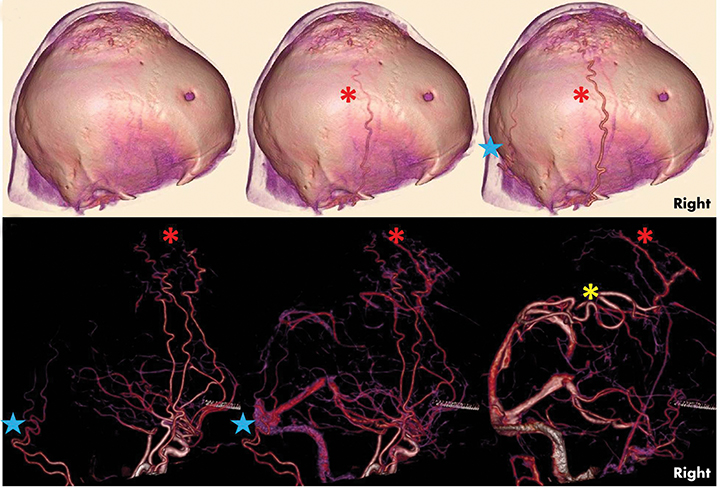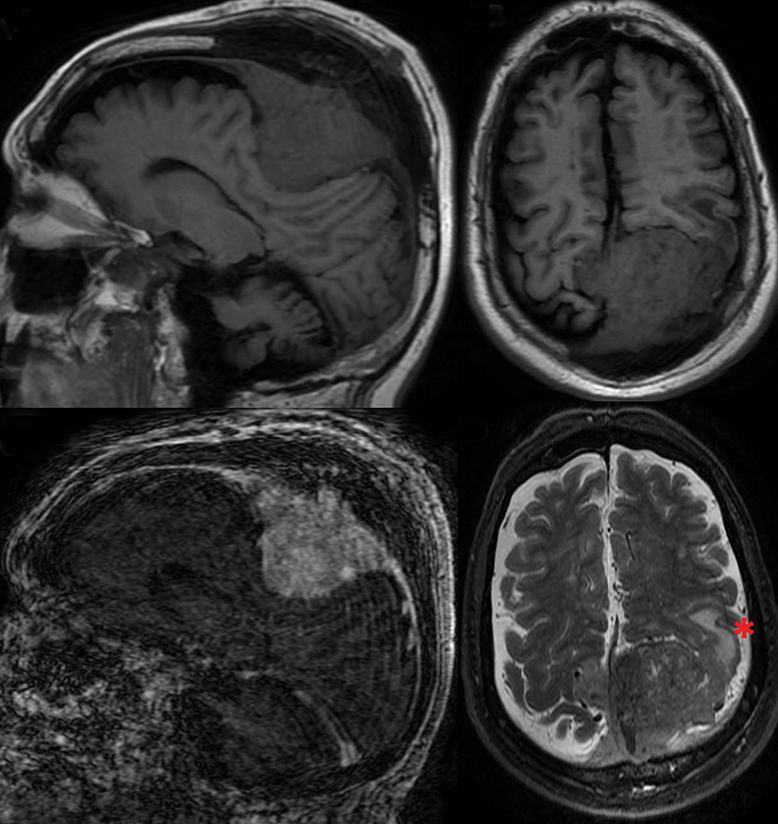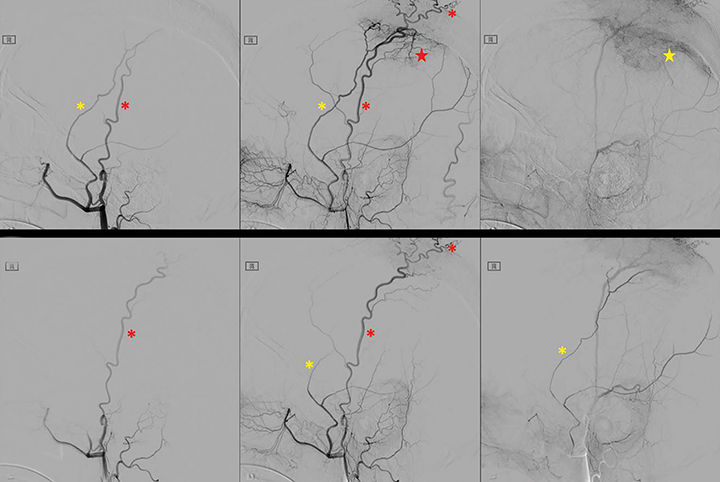4D-CTA and preoperative embolization of large intraosseous meningioma
Images





CASE SUMMARY
A 57-year-old man with a significant history of previously diagnosed small meningioma following a minor trauma presented with progressive, 1-week history of right upper and right lower-extremity weakness. On physical examination the patient had right shoulder abduction 3/5, deltoid 4/5, bicep 4/5 and triceps 3/5. The patient had subjective sensory deficits in the right upper and lower extremities, mild dysarthria and pronator drift. The initial workup, including brain MRI examination, was to rule out an ischemic event. On subsequent evaluation the patient was found to have a lump on the cranial vertex, which he reported was present for many years.
IMAGING FINDINGS
Coronal and parasagittal noncontrast CT images in soft tissue and bone window (Figure 1) showed a large, dural-based, partially calcified extra-axial mass causing remodeling and hyperostosis of the frontal and parietal skull at the vertex. The largest portion caused significant mass effect on the left central sulcus and a smaller soft tissue component along the outer cortical table at the vertex. 4D-CTA sequential dynamic images without and with bone subtraction (Figure 2) showed hypertrophied superficial temporal and occipital arteries feeding the meningioma on the arterial phase. They also revealed occlusion of the middle segment of the superior sagittal sinus with extensive collateral cortical vein hypertrophy, indicating a long standing process.
T1- and T2-weighted, pre- and postcontrast MR images (Figure 3) showed an avidly enhancing extra-axial mass with surrounding vasogenic edema centered at the left central sulcus but also extending to the right of midline. Finally, sequential right external carotid artery angiogram (Figure 4) revealed the hypertrophied superficial temporal artery supplying the outer portion of the tumor and the hypertrophied right middle meningeal artery feeding the central tumor tissue with early blushing and delayed retention of contrast. Sequential right external carotid artery angiogram images following sub-selective embolization of the right middle meningeal artery showed diminished flow in the middle meningeal artery and of the tumor blush. Superficial temporal artery remained visible. A gross pathologic image (Figure 5) showed a 6 × 6 × 4 cm multilobulated mass protruding through the meninges with a tan to white and solid surface.
DIAGNOSIS
Meningioma, WHO grade I, with intracranial, intraosseous and extracranial components
DISCUSSION
Meningiomas are the most common extra-axial intracranial tumor and the most common non-glial tumor.1,2 They are most common after the 5th decade of life and twice as common in the female as in the male population.2 Meningiomas are slow-growing tumors arising from arachnoid cap villi and histologically 90% represent WHO Grade I lesions,2,3 While often incidental and asymptomatic, meningiomas can present with symptoms secondary to mass affect, direct invasion, or CSF outflow obstruction.2 They are most commonly located in the parasagittal cerebral convexity, lateral hemisphere convexity, and the sphenoid wing. They can also occur in the middle cranial fossa, olfactory groove, orbit, ventricles, cerebellopontine angle, and spine among others.2 Rarely, cases of primary intraosseous meningioma have also been reported.2,3
On CT, meningiomas are round or elongated dural-based extra-axial lesions which are typically hyperdense relative to grey matter (70-75%). CT is especially useful in the evaluation of calcification which can be seen in 25% of tumors, as well as in the identification of hyperostosis and bone destruction. Approximately 15% of meningiomas feature cyst formation.4 On MRI, meningiomas are typically isointense with gray matter on T1- and T2-weighted images but occasionally hypointense areas due to calcification can be seen. These tumors typically feature avid postcontrast enhancement and a dural tail is seen 60% of the time. On angiography “sunburst” vascularity with dural and pial feeding vessels and a prolonged dense vascular blush are typical.4
Differential diagnosis for extra-axial dural based mass lesions includes metastatic disease, hemangiopericytoma, lymphoma, solitary fibrous tumor, and Rosai-Dorfman Disease, among others. Many of these meningioma mimics feature lower T2-weighted signal intensity and do not result in hyperostosis. These features which along with the individual patient’s clinical history can be a clue into distinguishing these lesions from meningioma.4
Preoperative meningioma embolization is a well-established safe option which can decrease intraoperative blood loss. The most commonly targeted feeder is the middle meningeal artery followed by the occipital artery and superficial temporal artery.5 Consideration for preoperative embolization is recommended for hypervascular tumors >3-4 cm with at least 50% of blood supply from accessible branches of the external carotid artery, in eloquent locations and with extensive calcifications.5 4D-CTA imaging is a noninvasive method which may be helpful in the evaluation of the degree of tumor vascularity, demonstration of hypertrophied external carotid artery feeders, and visualization of dural sinus invasion/occlusion. This technique can help narrow the differential diagnosis and can also be helpful in identifying cases which may benefit from preoperative embolization to minimize intra-operative bleeding. Embolization-related complications are uncommon (2.9%) but include parent vessel dissection, thromboembolic stroke, nerve palsy, and scalp infarction.5
CONCLUSION
Meningiomas are the most common benign intracranial tumor which are generally slow growing and can be asymptomatic or present secondary to mass affect. On imaging, these tumors are classically extra-axial featuring a dural tail, hyperostosis, homogenous avid contrast enhancement and calcification. Less commonly meningiomas can be intra-osseous. Prior to resection of large tumors 4D-CTA may be helpful to evaluate the need for preoperative embolization of external carotid artery feeding vessels to minimize intraoperative bleeding during surgical resection.
REFERENCES
- Smith AB, Horkanyne-Szakaly I, Schroeder JW, Rushing EJ. From the radiologic pathology archives: mass lesions of the dura: beyond meningioma-radiologic-pathologic correlation. Radiographics. Mar-Apr 2014 34(2):295-312.
- Watts J, Box G, Glavin A, Brotchie P, Trost N, Sutherland T. Magnetic resonance imaging of meningiomas: a pictorial review. Insights Imaging. January 2014 5:113-122.
- Agrawal V, Ludwig N, Agrawal A, Bulsara KR. Intraosseous intracranial meningioma. AJNR Am J Neuroradiol. February 2007 28: 314-315.
- Osborn AG. Osborn’s Brain. Philadelphia, Pa: Lippincott Williams & Wilkins, 2012
- Raper DMS, Starke RM, Henderson F, Ding D, Simon S, Evans AJ, Jane JA, Liu KC. Preoperative embolization of intracranial meningiomas: efficacy, technical considerations, and complications. AJNR Am J Neuroradiol. 2014 35: 1798-1804 originally published online on April 10, 2014, 10.3174/ajnr.A3919.
Citation
MF B, M B, MA J, JL S.4D-CTA and preoperative embolization of large intraosseous meningioma. Appl Radiol. 2018; (5):34-37.
May 4, 2018